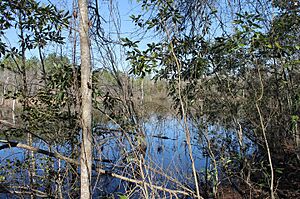Beaver Creek Indian Tribe facts for kids
 |
|
| Total population | |
|---|---|
| 550 | |
| Regions with significant populations | |
| Languages | |
| English | |
| Religion | |
| Christianity, Mormonism | |
| Related ethnic groups | |
| Waccamaw, Cheraw, Catawba and other Siouan peoples |
The Beaver Creek Indian Tribe is a small Native American group. They live in Orangeburg County, South Carolina. This tribe is officially recognized by the state of South Carolina. They received this recognition on January 27, 2006. The tribe is also working to get federal recognition from the United States government. They are part of the South Carolina Indian Affairs Commission.
The Beaver Creek people have lived in their historical lands for a long time. These lands are located between the two forks of the Edisto River. They lived especially along Beaver Creek. Records show the tribe has been in this area since the 1700s. Most members of the tribe still live there today. For many years, they worked mainly in farming. The tribe was quite isolated, living mostly in rural areas. Now, they are working to share their culture. They want to keep their Native American identity strong. They also want to teach others about their history and way of life.
The historical language of the tribe is Eastern Siouan. This language family connects them to other tribes in the Piedmont region.
Understanding the Tribe's Government
The Beaver Creek Indian Tribe has its own government. It is led by a chief and a vice chief. There is also a nine-member tribal council. All these leaders are chosen by election. An elders council also helps the tribal council. They offer advice and guidance. The tribe's land is located in Orangeburg County.
A Look at the Tribe's History
Many records from the American Revolutionary War era show the Beaver Creek people were identified as 'Indian'. This helped the tribe gain state recognition in the early 2000s. These records proved that their cultural identity continued over many years.
In the mid-1800s, the tribe asked the state of South Carolina about a certain tax. This tax was called a poll tax. They wanted to know if people of Indian descent were considered "free persons of color." This showed their efforts to define their identity.
During the mid-1800s, some census records listed their people as "mulatto." In the early 1900s, some birth and death certificates called them "Croatan." This term was often used for people of mixed Native American heritage. Many tribal members were also listed as "Indian" on World War I enlistment forms.
A school called Four Pines School for Indians was started in the early 1900s. It was near Rocky Swamp. Beaver Creek Indian children and Pee Dee Indian children went to this school. They attended until the 1960s. That's when public schools in South Carolina were desegregated. Many elders shared stories in the early 2000s. They said their families felt they had to keep their Native American identity a secret. They were often told not to talk about being Indian in public.


